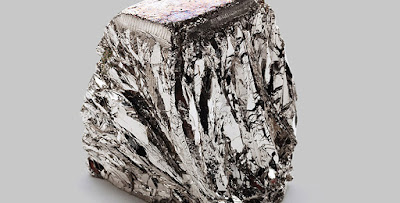What is bismuth?
Bismuth is a gleaming and fragile metal that is much of the
time found in low-soften amalgams. Interest for bismuth metal has become in the
course of recent years in extensive part because of its compelling use as a
substitute for lead.
Properties:
Nuclear Symbol: Bi
Nuclear Number: 83
Component Category: Post-move metal
Thickness: 9.78 g/cm3 (20°C)
Liquefying Point: 272 °F (521 °C)
Breaking point: 1564 °F (2847 °C)
Moh's Hardness: 2.25
Attributes:
Bismuth is a fragile, shiny green metal that has a low
softening temperature and high particular gravity.
Being both stable and non-dangerous, bismuth is frequently
utilized as a substitution for harmful metals, for example, antimony, cadmium,
lead, and mercury.
Like water, bismuth is less thick as a strong than as a
fluid (it extends as it cools), a property one of a kind for a metal. Of all
the metal components, bismuth likewise has the most astounding electrical
resistance and the least thermo-conductivity (with the exception of mercury),
and in addition the most astounding Hall Effect (increment in electrical
resistance when set in an attractive field).
History:
Bismuth was first perceived amid the Middle Ages, in any
case, with no capacity to disengage the metal it was frequently mistaken for
tin, lead, antimony and zinc. In 1450, German minister Basil Valentine
initially made reference to wismut, or 'white lead', which would later be
Latinized as bisemutum.
Extraction of bismuth for use in shades started as ahead of
schedule as the fifteenth century from silver mines in Schönberg, Germany. In
the mid-eighteenth century, look into by Johan Heinrich Pott and Claude
Geoffroy prompted a superior comprehension of bismuth and its exceptional
properties.
Restorative professionals were, right now, likewise getting
to be plainly mindful of bismuth's helpful properties in treating gastric
conditions.
The main metallurgical uses for bismuth were in pewter
combinations, where it was utilized with lead and tin to bring down the
dissolve temperatures, and in amalgams with antimony for printing press sort
metals.
A noteworthy jolt to the bismuth business came in the
mid-1990s with the Safe Drinking Water Act Amendment (1995), which denied the
nearness of lead in drinking water installations in the US. For as far back as
20 years, the sans lead development has brought about bismuth's selection in an
extensive variety of utilizations.
Creation:
Bismuth frequently happens actually in the sulfide mineral
bismuthinite (Bi2S3) or the oxide metal bismite (Bi2O3). Be that as it may,
extraction of such minerals exclusively for its bismuth substance is
infrequently temperate and bismuth is, rather, principally created as a
by-result of lead refining. In China, vast amounts of bismuth are likewise
separated from tungsten, tin and zinc metals.
Extraction of bismuth metal from lead regularly happens by
means of one of two procedures; the Betterton-Kroll Process or the Betts
Process.
The Betterton-Kroll Process isolates bismuth from lead
through the presentation of calcium or magnesium into a liquid arrangement of
the lead and bismuth. The subsequent calcium or magnesium bismuthide, being
lighter than liquid lead ascends to the surface as dross (strong pollutions)
and can then be evacuated. The dross is then treated with chlorine at
temperatures of around 572-932°F (380-500°C) to evacuate the magnesium or
calcium.
High virtue bismuth is created after treatment utilizing
sodium hydroxide.
The Betts Process includes electrolytic refining of lead
bullion. In a synergist arrangement, unadulterated metallic lead plates onto
the anode, while polluting influences, including bismuth, settle to the base of
the vessel. The sloppy blend of metals can be liquefied to deliver a metal
composite and a bismuth-rich slag, which is then decreased with carbon to create
bismuth metal.
In China, blended concentrates of bismuth are delivered by
draining, attractive partition as well as differential buoyancy methods.
Concentrates are then purified to create unrefined bismuth for refining.
The biggest bismuth creating nations are China, Peru, Mexico
(unrefined and refined) and Belgium (refined). In 2013, the US Geological
Survey assessed worldwide world refined bismuth creation to be around 17,000
metric tons.
Of this, Chinese creation represented roughly 90 percent.
With more than 70 bismuth mines, China likewise represents most by far of
worldwide bismuth saves.
Real bismuth makers incorporate Hunan Nonferrous Group
(China), Shizhuyuan Nonferrous (China), Penoles (Mexico), Sidech (Belgium), and
MCP (UK).
Applications:
Because of bismuth's weakness, unadulterated types of the
metal are not utilized as a part of metallurgical applications. It is, in any
case, utilized as an added substance amalgam in copper, aluminum, iron and
steel as a substitute for lead and to toughen and make composites that are more
machineable.
Take after the connection here to peruse more about bismuth
metal applications.
Sources:
Elementymology and Elements Multidict. Bismuth.
http://elements.vanderkrogt.net/element.php?sym=Bi
US Geological Survey. Bismuth.
http://minerals.usgs.gov/minerals/bars/product/bismuth/

Emoticon